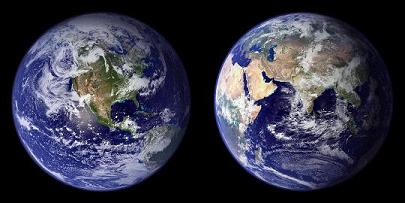The Blue Marble
|
|
"The Blue Marble" is a famous photograph of Earth taken on 7 December 1972 by the crew of the Apollo 17 spacecraft at a distance of about 45,000 kilometers or about 28,000 miles. [1] (http://svs.gsfc.nasa.gov/vis/a000000/a002600/a002680/). It is one of the most widely distributed photographic images in existence. Earth is said to have the appearance of a child's marble in the photo; that is the Earth has the same aspect at this distance as a child's marble at about arm's length.

The time of Apollo 17's launch, 05:33 UTC (12:33 a.m. EST) on 7 December, meant that Africa would be in daylight during the early hours of the spacecraft's trip to the Moon. With the December solstice approaching, Antarctica was also illuminated. The photograph was taken at about 10:39 UTC (5:39 a.m. EST), about 5 hours 6 minutes after the launch [2] (http://history.nasa.gov/alsj/a17/images17.html#Flight), and about 1 hour 48 minutes after the spacecraft left parking orbit around the Earth to begin its trajectory to the Moon. The photograph's official name is AS17-148-22727. The camera used was a 70-millimeter Hasselblad electric camera with an 80-millimeter lens.
NASA officially credits the image to the entire Apollo 17 crew — Eugene Cernan, Ronald Evans and Jack Schmitt — all of whom took photographic images during the mission with the on-board Hasselblad camera. Schmitt later claimed that he personally took the famous image, but the identity of the photographer is unverifiable.
Apollo 17, notably, was the last manned lunar mission. No humans since have been at a range where taking a "whole-Earth" photograph such as "The Blue Marble" would be possible.
"The Blue Marble" was the first clear image of an illuminated face of Earth. Released during a surge in environmental activism during the 1970s, the image was seen by many as a depiction of Earth's frailty, vulnerability, and isolation amid the expanse of space. NASA archivist Mike Gentry has speculated that "The Blue Marble" is the most widely distributed image in human history.
Subsequent similar images of Earth (including composites at much higher resolution) have been also been termed "blue marble" images, and the phrase "blue marble" (as well as the picture itself) is used frequently by environmental activism organizations or companies attempting to promote an environmentally-conscious image. There has also been a children's television program called The Big Blue Marble.
External links
1972 photo
- The one, the only, photograph of Earth (http://neil.fraser.name/writing/earth/) a short list of places in which the image has been used.
- Apollo Image Atlas (http://www.lpi.usra.edu/research/apollo/catalog/70mm/magazine/?148) Photos from magazine NN of the 70mm Hasselblad camera used on Apollo 17 (includes the Blue Marble photo and others quite similar to it)
21st century NASA composite image
- "Visible Earth" (http://visibleearth.nasa.gov/cgi-bin/viewrecord?11656) NASA "Blue Marble" imagery
- Blue Marble Navigator (http://www.blue-marble.de) Web interface for viewing local sections of a high-resolution composite image
- Blue Marble Mapserver (http://www.geobserver.com/worldview_eng.php) - fast & easy to use interface for browsing through Blue Marble subset imagespt:O Mármore Azul

